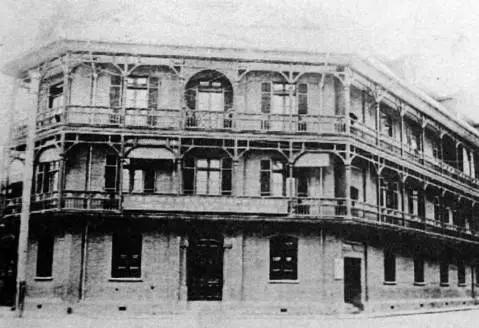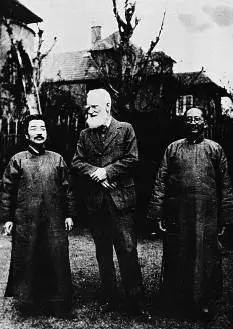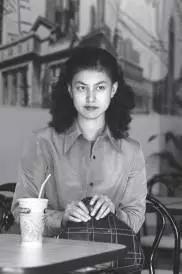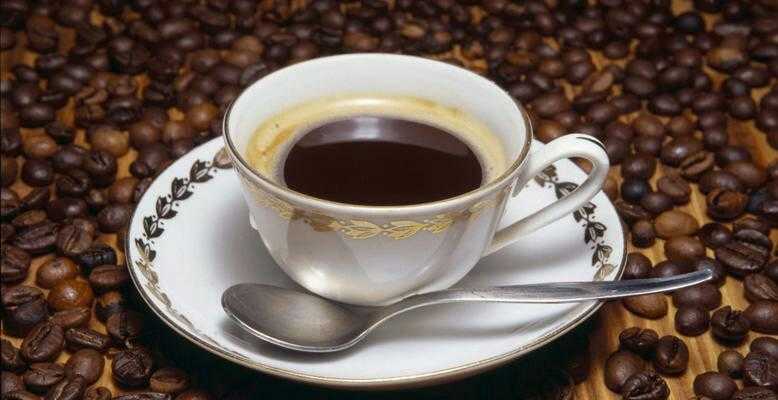When did Chinese people drink coffee?
Follow the caf é (Wechat official account vdailycom) and found that Beautiful Cafe opened a small shop of its own.

Interior view of the coffee shop in Dongcheng, Beijing, 1994
Since coffee first arrived in China in 1884, it seems hard to say how many people like coffee from the bottom of their hearts. The popularity of coffee in China has nothing to do with whether the coffee itself is good or not.
If you see the cafes on the streets of China today, the literary masters of the Republic of China may be quite surprised: although there are cafes in their world, they do not have much experience in drinking coffee, nor do they leave beautiful articles on how to drink coffee. They are used to drinking tea. Even if he is as extreme as Lu Xun-he has to go to a cafe to socialize, he always brings his own Chinese tea.
Not many people seem to like coffee from the bottom of their hearts-but the popularity of coffee in China has nothing to do with the taste of coffee itself.
Foreigners brought coffee trees as well as cafes.
Human beings have been drinking coffee for nearly a thousand years, but coffee really spread to China in the 19th century. In 1884, a Manchester tea merchant named Lawrence came to Taiwan, a treasure island of China, through the rumbling gunfire of the Chinese and French navies. The middle-aged man who had been trading in Africa and South America found that Taiwan's climate was similar to that of the Caribbean coast, which is rich in coffee. So he came up with the idea of reclaiming coffee plantations.
He shipped more than 100 coffee trees from Manila, Philippines, and began to plant them in Taiwan. Because of the long transportation distance and poor care after planting coffee seedlings, only 10 coffee trees have survived. But in any case, this is the prelude to the development of coffee in China.
As for Chinese mainland, the earliest coffee cultivation began in Yunnan. In 1904, Tian Deneng, a French Catholic missionary, was ordered to preach in Binchuan County, Dali. He is so fond of coffee that he has coffee beans and saplings he bought when he passed through Vietnam, where the French planted coffee about 100 years ago. This time, Tian Deneng wants to try it in Binchuan so that he can drink fresh coffee at any time.
He came to Zhukula Village in Binchuan County, built a church and planted a coffee forest on the edge of the church, that is, the Zhukula village coffee forest that has been preserved to this day as a "living fossil" of Chinese coffee. At first, the coffee produced here was only for the priest to drink, but slowly, the local villagers drank the coffee with the priest.
After a hundred years, drinking coffee has become a living habit of the local minority people in Zhukula village. After peeling and shelling the picked coffee beans, they stir-fry them directly in a large iron pot for cooking, then pestle them into pieces, grind them into fine coffee powder with a stone mill, wrap them with gauze and cook them in earthen pots.
In 1905, another Frenchman opened the Yunnan-Vietnam Railway Bar at the earliest trading port in Yunnan. This is actually a cafe, so why call it a bar? It turns out that this is a cafe with French characteristics, selling not only coffee, but also alcoholic beverages. it is a mixture of cafes and taverns, and it is also the mainstream model of European cafes.
At that time, as soon as the bar was built, it attracted the French and other foreigners who came here to build the Yunnan-Vietnam railway. At that time, the local people were very puzzled by this: "it's really strange!" Lao Yangmi (what people used to call foreigners) does not drink tea, but drinks something as bitter as traditional Chinese medicine. "
However, as more and more foreigners are blinded by themselves, they are not surprised. The local gentry slowly began to deal with foreigners and went to foreigners' houses. They had no tea but coffee. If they drank too much, they became addicted to it.
I didn't go to the cafe for coffee.
The cafes in Shanghai will come earlier. In the hundred songs of Shenjiang in 1887, a piece of bamboo ci wrote: "one dish is chewed and one bowl is full to drink Gaojiao at will." The word "Gao Yi" here is the early translation of coffee.
The early cafes in Shanghai were run by foreigners, especially for those homesick sailors who had just left the cargo ship in the mid-19th century.
Naturally, the first regular customers of the cafe became prostitutes who specialize in the sailor business. It was only after that that it began to attract Chinese who tried to emulate the Western way of life. By 1909, coffee shops began to be seen as party places and appeared in guidebooks in Shanghai.
In 1911, Humboli Cafe in Hongkou, Shanghai
Unlike today's coffee shops, which mainly sell coffee, most of them are French coffee shops, similar to the "Yunnan-Vietnam Railway Bar" model, which is attached to restaurants and sells all kinds of food and drinks.
Carpets were laid at the entrance, gramophones played popular Western music, and tables were filled with imported vases and ashtrays-cafes at the time were basically exhibitions of the Western way of life.
A novel at that time depicted the scene in a cafe: the well-dressed Miss Zhong, surrounded by three young men, boasted about her life in Paris.
At this time, the waitress in the cafe also replaced the prostitutes who used to occupy the place. In fact, this is true not only in Shanghai, but also in the whole country. At that time, Yan Qiyu, a journalist from Changsha, wrote in the news, "many people (go to coffee shops) do not necessarily drink coffee, but eat waitresses."
In the 1930s, cafes in Changsha sprang up one after another, and the waitresses of the Youth Banquet Club at the south gate can be called the success of Changsha. The men in Changsha come here in the name of drinking coffee, not to order coffee, but to order Ye Hong, a famous waitress here, to watch her play "Peach Blossom River" with a harmonica. Or order the waitress Yinzhen and listen to her sing the 90% discount "Su San Jie Jie".
Later, there was a waitress "beauty pageant", that is, the election of a "coffee queen". This is close to the selection of Huakui in the youth house, and it is a major local event. similar to the current talent show, waitresses from major cafes have their own fans, and the competition is extremely fierce.
Beauty waiters bring business to coffee shops, while some people dig corners. When beauty waiters are elected or shortlisted for the "coffee queen" and attract people's attention, they will naturally change jobs from this coffee shop in Changsha to another one because of their different prices.
The most famous waitress in Changsha is Hu Ping, who later became a movie star. Before she became famous, she worked as a waitress in the far East Cafe, the earliest coffee shop in Changsha.
In 1936, the Changsha newspaper reported that "Hu Ping, who is now the basic actress of the Shanghai Star Film Company, was a sensational modern girl who once acted as the maid of the shop, so at that time, the general dandy flocked to eat only one or two cents, but tipped to more than a few yuan, covered with the role of 'drunk Weng's intention is not drunk', and was attacked by public opinion, so he left Hunan for Shanghai and presented his voice on the screen."
Later, when Tian Han returned to Changsha, he often had to sit in the coffee shop in the far East. His impression of the cafe was, "the waitresses there seem to be a little conceited, as if everyone has the hope of becoming a movie star in the future."
Waitresses in coffee shops have also become a favorite theme for writers. In Tian Han's "one Night in a Coffee Shop", the heroine Bai Qiuying runs to Shanghai to find her childhood lover and works as a waitress to make ends meet. In the end, her long-awaited lover finally showed up at the coffee shop, but brought his fiancee at the same time. Bai Qiuying scolded the other side for being heartless and set fire to the banknotes he gave.
The story that happened in the cafe, although a bit old-fashioned, already has some meaning of women's liberation.
In Shanghai, cafes have become a cultural craze.
In the 1920s, coffee shops in Shanghai were mainly concentrated in the French concession and Hongkou (Japanese concession). In the Xiafei Road, Jing'an Temple Road and Shaanxi North Road in the French concession, most of them are French coffee shops, and some are run by Russians. they are large in scale, high-grade, and attract dignitaries from the upper class.
As for the cafes in Hongkou District, which are all over the North Sichuan Road and are mostly run by intellectuals, they are simpler and cheaper, attracting people from literary and art circles.
In 1928, Shenbao published a short article in which the author signed "Shen Zhi" introduced the reader to a coffee shop called "Shanghai Coffee" located on North Sichuan Road in Hongkou District. In the store, the author met many literary and art celebrities, including Lu Xun, Yu Dafu, Gong Binglu, Meng Chao and Ye Lingfeng, who either talked about their opinions or meditated silently. Careful to indulge in this atmosphere, and decided that this is his idea of an "ideal paradise".
However, this short article about cafes has sparked a debate. Yu Dafu published a Revolutionary Advertising, denying that he had anything to do with Shanghai Coffee and attacking contemporary intellectuals' blind fascination with the concept of revolution.
Lu Xun quickly joined in. In the article "Revolutionary Cafe", he said he had never been to such a coffee shop. What he resents is that the waitresses in the cafe who are only talkative "writers" and "young and beautiful waitresses with white teeth and red lips" do not want to be "decorated" in revolutionary cafes at all.

On February 17, 1933, Bernard Shaw, an Irish playwright, critic and Nobel laureate in literature, visited China and took a group photo with Lu Xun and Cai Yuanpei in Shanghai.
However, if you object to it, you still have to go to the cafe. For left-wing intellectuals, because the national government paid less attention to the cafes opened in the Japanese concession, it was really a good place to party. A year after the Revolutionary Cafe was written, Lu Xun went to the Public Cafe, which was close to his residence in Shanghai at that time.
Gongfen was located near the tram terminal on Shanghai North Sichuan Road and opposite the Neishan Bookstore at that time. The first preparatory meeting of the League of the left was held on the second floor of the Public Cafe on February 16, 1930. The meeting decided to set up a revolutionary literary group, the League of the left. Lu Xun presided over the preparatory meetings for the League of the left many times. So he also became a regular customer of public coffee. But he never drinks coffee and usually brings his own Chinese tea.
Lu Xun's view of coffee is basically negative. He used to say, "I spend all my time drinking coffee at work." He believes that drinking tea is to eliminate fatigue and work better. Coffee, on the other hand, is all about pleasure, wasting time on meaningless talk.
But it is precisely because of the common space of cafes that the cultural craze can sprout. In 1928, a new column "Cafe" appeared in Shenbao, and the editor at that time made it clear that this column was like a real-life coffee shop, where people were free to exchange views on any topic.
In fact, for Lu Xun, the cafe is also an indispensable social place. If the literary youth at that time wanted to meet Lu Xun, they had to go through the route, including public coffee.
In 1934, Xiao Jun and Xiao Hong came to Shanghai from the northeast with manuscripts of their novels. They first went to the Neishan Bookstore to meet Lu Xun, and then Lu Xun took them to have a chat with public coffee. Zhou Yang's wife also recalled that at that time, she asked Zhou Yang to wait in the public caffeine, first went to the Neishan bookstore to find Lu Xun, and then the three of them had a long talk together in the small private room on the second floor of the public coffee.
Instant coffee was also a symbol of style at that time.
After the founding of the people's Republic of China, coffee, together with cafes, gradually disappeared from the public's view. However, it is not entirely absent. In Shanghai, in order to "develop the economy and ensure supply", the commercial sector serves coffee and simple western food in a small number of stores, mostly in the old concession. After all, the residents there have been drinking coffee since childhood.
Coffee is also available at the Central Mall on Nanjing East Road. Some Shanghainese recalled that at that time, the central shopping mall was drinking coffee, sitting on eight Immortals tables and benches, and revolutionary slogans were affixed to the walls. The coffee is made in an aluminum pot that boils water. Pour it into a glass, add a small spoonful of granulated sugar, and stir it with bamboo chopsticks.
There's also bread toast, but it's more expensive. The people who come to drink coffee are all old people who soak a cup of coffee for half a day. More people queue up to the side to buy big bags of fresh meat and eat oil piers.

A young woman in a coffee shop in Dongcheng, Beijing, 1998
In Beijing, there are also cans of Shanghai coffee worth 3 or 4 yuan on the shelves of Xidan Mall. However, for ordinary people, this is really a sky-high price. Some foreign-related hotels also have their own coffee shops, but they need foreign exchange coupons to pay the bill.
It was not until the 1980s that China got to know coffee again from television. "it's delicious!" I believe many people still remember this Nestle Coffee advertisement today. The charm of this advertisement is that instant coffee mixed with a cream partner is a fragrant and sweet drink for people who have never had coffee. For people who have drunk coffee, most of them are not used to the bitter taste of coffee, so they are happy to accept that coffee has become so sweet.
The success of Nestle instant coffee has made it a symbol of "forcing". At that time, glass bottles containing Nestle, even if they were empty, were often placed in glass cabinets as furnishings, or taken to the office as drinking cups.
But it also gives most Chinese the wrong impression of coffee: coffee is "Nestle", coffee is "bitter", and coffee should be mixed with "partner". So when Starbucks entered China in 1999, when many people drank the first cup of Starbucks coffee, the first reaction was that there were so many different ways to drink coffee.
Important Notice :
前街咖啡 FrontStreet Coffee has moved to new addredd:
FrontStreet Coffee Address: 315,Donghua East Road,GuangZhou
Tel:020 38364473
- Prev

Amoy Coffee: this is a completely transformed shopping experience.
Follow the caf é (Wechat official account vdailycom) found that the beautiful cafe opened a small shop of its own Alibaba CEO Zhang Yong said yesterday (11) about the unmanned retail store "Amoy Coffee", Ali will continue to try to create this kind of "new species"; Alibaba will not be familiar with the supermarket or cafe, the new retail scene has the opportunity to be redefined, master
- Next

The three stages of coffee learning, are you the same?
Following Cafe Review (Wechat official account vdailycom) found that Beautiful Cafe opened a small shop of its own 1 | the goddess of idolatry in the early semester said that idol worship is more common in beginner coffee friends, and the object of worship may also be a teacher who has just taken a class. When you first enter the door of coffee, too many new things come one after another: pull flowers, extract.
Related
- What is the standard process for the purpose of coffee cup testing? What is the difference between hand-brewed coffee and cup testing?
- How to use hand-brewed coffee paragon small golden balls? How does cold coffee lock in the aroma of coffee?
- Is American coffee black? What is the difference between American coffee and drip coffee?
- Unexpected! Well-known tea beverage brand Lele Tea will withdraw from the Zhengzhou market!
- Starbucks enters the fashion and beauty industry?! Netizen: Give me an ice American eye cream
- Why can American refills for free? The difference between Americano and American drip pot coffee
- Being chased out of the rain in front of Starbucks?! Store: Sheltering from rain under umbrellas poses a safety hazard
- The white moonlight has changed?! Lucky launches "Big Winter Pear American"
- Hand-brewed coffee three-stage method, high-sweet and universal brewing method to share! What does the high sweet water level of hand-brewed coffee mean?
- What is the difference between raw, refined and full espresso coffee? How to extract espresso and taste good?

